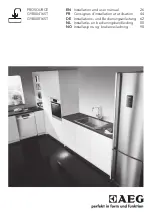
7
Inspection and maintenance
Installation and maintenance instructions
36
Daikin Altherma EHS(X/H)
Daikin Altherma integrated solar unit
008.1444099_00 – 07/2018 – EN
7
Inspection and maintenance
7.1
General overview of inspection
and maintenance
Regular inspection and maintenance of the Daikin Altherma EHS(X/
H) reduces the energy consumption and ensures a long service life
and trouble-free operation.
WARNING
The overall heat pump system contains refrigerants with
fluorinated greenhouse gases that are harmful to the envir-
onment when released.
Refrigerant type: R32
GWP* value: 675
*GWP = Global Warming Potential
▪ Enter the total filling quantity of refrigerant on the label
supplied on the external heat pump unit (for notes, see
Installation instructions for the heat pump outdoor unit).
▪ Never allow refrigerant to escape into the atmosphere -
always extract and recycle with a suitable recycling
device.
INFORMATION
Have the inspection and maintenance carried out by au-
thorised and trained heating engineers once a year and, if
possible,
before the heating period
. This will avoid mal-
functions during the heating period.
We recommend an inspection and maintenance contract to
ensure regular inspection and maintenance.
Legal requirements
According to F-Gases Directive (EC) No. 842/2006 Article 3, re-
placed on 01/01/2015 by (EC) No. 517/2014 Articles 3 and 4, operat-
ors (or owners) must regularly maintain their fixed refrigeration sys-
tems, check for leaks and have any leaks rectified immediately.
All installation, maintenance and repair work on the refrigerant circuit
must be documented, e.g. in the operating manual.
The operator has the following obligations for our heat pump sys-
tems:
INFORMATION
The European legal inspection period applies to heat
pumps with a total filling quantity of the system with refri-
gerant of 3 kg or from 01/01/2017 with a total filling quant-
ity of 5 t CO
2
equivalent.
However, we recommend concluding a maintenance con-
tract including documentation of the work carried out in the
operating manual to safeguard warranty claims, even for
systems for which there is no legal obligation to check for
leaks.
▪ With a total filling quantity of refrigerant of 3 kg - 30 kg or from
6 kg in hermetic systems and from 01/01/2017 with a total filling
quantity of refrigerant of 5-50 t CO
2
equivalent or from 10 t CO
2
equivalent in hermetic systems:
▪ Inspections by certified personnel at intervals of no more than
12 months and documentation of the work carried out in accord-
ance with the valid regulation. This documentation must be kept
for at least 5 years.
INFORMATION
Certified persons are those who have an expert certificate
for work on stationary cooling systems (heat pumps) and
air-conditioning units in the European region in accordance
with the F-Gases Directive (EU) No. 303/2008.
▪ Up to 3 kg total filling quantity of refrigerant: Expert certi-
ficate category II
▪ From 3 kg filling quantity of refrigerant: Expert certificate
category I
Maintenance work to be carried out annually
WARNING
Work carried out improperly on the Daikin Altherma
EHS(X/H) and its optionally connected components can
endanger human life and health and affect the function of
these components.
▪ Work on the Daikin Altherma EHS(X/H) (such as main-
tenance or servicing) must only be carried out by per-
sons who are authorised and who have successfully
completed qualifying technical or vocational training and
who have taken part in advanced training sessions re-
cognised by the relevant authorities responsible for the
specific activity. These include, in particular, certified
heating engineers, qualified electricians and HVAC spe-
cialists who, because of their professional training and
expert knowledge, have experience in the professional
installation and maintenance of heating, cooling and air
conditioning systems and heat pumps.
WARNING
The gaseous refrigerant is heavier than air. In pits or in
badly ventilated rooms, it can collect in high concentra-
tions. Breathing in high concentrations of gaseous refriger-
ant leads to feelings of faintness and suffocation. Toxic
gases can be formed if gaseous refrigerants come into
contact with open fire or hot objects.
▪ When working on the refrigerant circuit, ensure that the
workplace is well vented.
▪ If necessary, before starting work, evacuate the refriger-
ant system completely.
▪ Never carry out work on the refrigerant circuit in closed
rooms or work pits.
▪ Do not let refrigerant come into contact with open fire,
embers or hot objects.
▪ Never allow refrigerant to escape into the atmosphere
(forms high concentrations).
▪ After removing the service pipes from the filling connec-
tions, carry out a leakproof test on the refrigeration sys-
tem. Refrigerant can escape through leaks.
WARNING
At normal atmospheric pressure and ambient temperat-
ures, liquid refrigerant vaporises so suddenly that on con-
tact with skin or eyes it can cause the tissue to freeze
(danger of going blind).
▪ Always wear safety goggles and protective gloves.
▪ Never allow refrigerant to escape into the atmosphere
(high pressure at the point of the leak).
▪ When removing the service pipes from the filling connec-
tions, never hold the connections in the direction of your
body. Residual refrigerant could escape.
















































